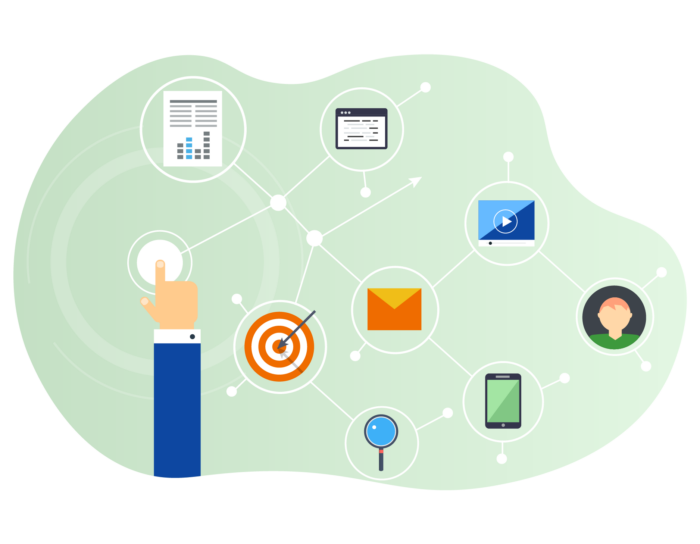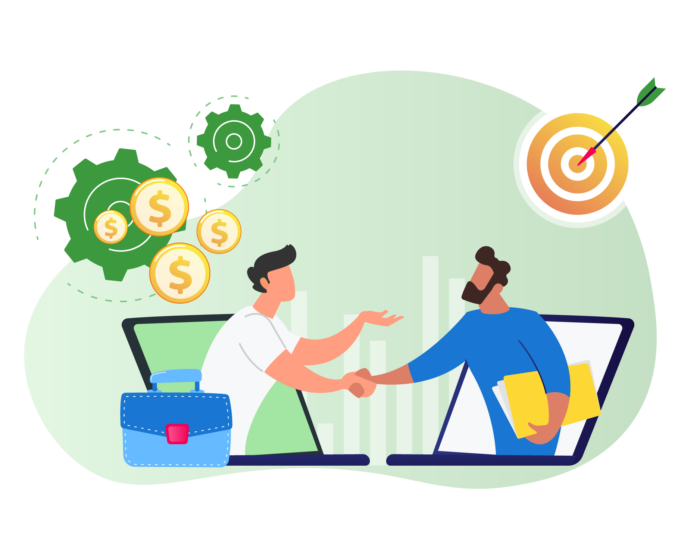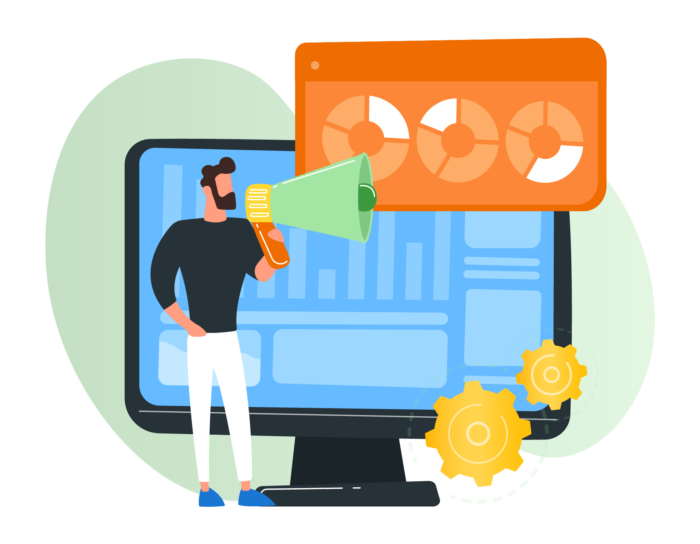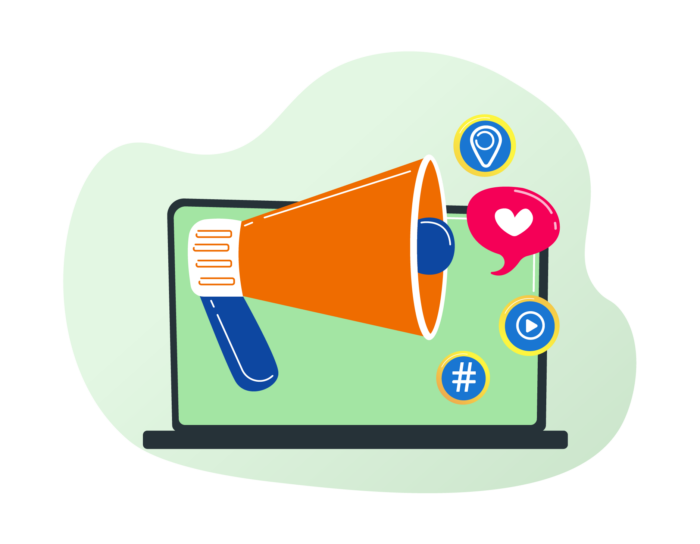Guide to Effective B2B Marketing for 2020
Even before the COVID-19 pandemic, the prospect of a contentious election in the United States and lackluster financial projections worldwide were clouding business horizons. Business-to-business (B2B) marketers’ strategies for 2020 are “overridden by one factor more than any other: uncertainty,” says Polly Kay, senior marketing manager at English Blinds.
Compounding the grim human costs of the pandemic, the economic disruption has pulled the rug out from under B2B marketing departments that traditionally rely on trade shows for face-to-face introductions to new clients. The spread of COVID-19 across the world forced cancellation of approximately 500 trade shows worldwide, erasing 270,000 full-time equivalent (FTE) jobs worldwide and $26.2 billion per month in global economic activity.

“B2B firms are already seeing the beginnings of disruptions that are going to continue throughout the rest of the year, and quite possibly beyond it, too,” Kay says.
How can you adapt your B2B marketing to cope with this extreme situation? How can you keep your lead funnel full when events, the largest slice of most B2B marketing budgets, are suspended? What are the best ways to nurture leads into deals using digital channels exclusively?
We worked with experts to find the answers, which we offer in this comprehensive guide to B2B marketing for 2020.
Chapter synopsis
This guide consists of five chapters:
- Chapter 1: Introduction.
- Chapter 2: What is B2B marketing? What defines B2B marketing? How does it differ from B2C marketing? We cover the basics as well as the trends in the industry both now and in the future.
- Chapter 3: Top B2B marketing KPIs. We discuss the key performance indicators B2B marketers need to track, and review some leading apps and digital tools to automate metric tracking.
- Chapter 4: The most effective B2B marketing channels. Flip ahead to this chapter to learn more about the major marketing channels from a B2B perspective — social media, email, video, and search — as well as the state of event-based B2B marketing.
- Chapter 5: Examples of great B2B marketing. Lessons from six of the top B2B marketing campaigns of years past.
Each chapter stands on its own, so feel free to skip ahead for answers to specific questions. And remember to bookmark this page. Much of what we cover is evergreen. The lessons we’re learning now may prove remarkably useful in the inevitable crises to come.
What is B2B marketing?
What do local radio spots aimed at small business owners, a business networking happy hour, volunteering on the board of the local chamber of commerce, and making presentations at trade shows have in common? Each is an example of B2B marketing, a term that encompasses so much that it’s hard to define succinctly.
What is B2B marketing?
Let’s break the term down into its component parts. B2B stands for “business-to-business.” Compare B2B companies to B2C, or “business-to-consumer,” operations. If you sell candy bars to the general public, you operate a B2C business. If you sell boxes of candy bars to corporate employee snack programs, you’re in the B2B space.

Here’s the American Marketing Association’s definition of marketing:
Marketing is the activity, set of institutions, and processes for creating, communicating, delivering, and exchanging offerings that have value for customers, clients, partners, and society at large.
To put it all together, B2B marketing involves communicating one company’s products or services (including software as a service) to other businesses and organizations. B2B is marketing between companies, as opposed to marketing by one company to the public at large.
B2C vs B2B marketing
Consumers are individuals who purchase products or services from a company. Most successful B2C marketing campaigns use simple messaging, emotional arguments, and wide targeting.
The B2B audience is different. They are much more analytical when making purchasing decisions. Far less interested in fads, they value what improves productivity and eliminates waste. Business buyers demand to know exactly how your offering is worth their money. Here’s a snapshot of the B2B vs B2C marketing dichotomy:
- In B2B marketing, there is rarely a single decision-maker. More often than not, it’s a team of people. In a sense, “business-to-business” is a misnomer. All marketing is between people, after all. But in the B2B space, you may have to address the needs and preferences of multiple stakeholders within a company to seal the deal. B2C campaigns are more likely to rely on emotional appeals to an individual.
- The B2B sales cycle is a lot longer than B2C. On one hand, this means there are more opportunities for your prospects to jump ship. But it also means you have more time to share crucial, decision-changing information and to cultivate a relationship for the long run.
- B2B marketing campaigns are more data driven than B2C campaigns. A chief financial officer isn’t persuaded because your copy is pithy. They care how your business will provide a good return on investment. You need numbers to make your case.
For more on the differences between B2B and B2C marketing, check out our blog.
The unique characteristics of B2B marketing are clear when you examine recent industry trends. Below are some key B2B marketing trends already gaining momentum and what some experts believe marketers can expect in the years to come.
B2B marketing trends
Digital connections have been increasingly important for B2B marketers for years, and the pandemic will accelerate that trend, says Lance Cummins, founder of Nectafy and Anyvoo.
“What you’re seeing now is a huge acceleration of a gradual trend, which is that you’ve got to learn to deal with your audience digitally,” Cummins says. “You’ve got to get people to pay attention to you, even if you’re not physically standing in their way at a trade show.”
The numbers support Cummins’s point. In 2019, U.S. marketing spend for offline media declined by 5.9 percent, reports Winterberry Group’s Outlook for Data Driven Advertising & Marketing 2020, while budgets for online marketing efforts grew 19.1 percent.
Two of the three traditional marketing categories that helped offset the overall decline in offline spending in 2019 were outdoor media (billboards, posters) and experiential marketing (events). It seems likely that widespread stay-at-home orders will affect those two categories in 2020, hastening the decline of traditional marketing channels.
Here are a few more of the trends marketers are following this year:
- Content marketing remains a big part of digital attention seeking, but increasingly savvy B2B audiences will demand higher quality, demonstrably useful material, Cummins says. “The future of content marketing, and this is not revolutionary, is literally about this: How do we provide more substantive help?” he says. “The noise is so much greater [in 2020]; therefore your focus has to be narrower. Your expertise has to be more helpful rather than self-interested.”
- Marketers in the coming years will benefit from a shift in branding away from the company toward the individuals who work there, says Alex Panagis, founder of ScaleMath. “In previous years, businesses would choose to work with a specific company because of the name value in the industry,” Panagis says. “That is not really the case anymore. Businesses buy into people they like and believe share the same common values as them.” To take advantage of this trend, consider positioning employees as thought leaders, investing in their personal brands, and nurturing their personal audiences.
- In the near future, personalized messaging, not big data, could be what makes the difference between gaining a lead and driving one away. “In previous years, everyone has been too focused on automating their marketing, sending templated and canned emails to get maximum results with the minimum investment,” says Adam Hempenstall, CEO and founder of Better Proposals. “It’s not working anymore, and B2B audiences crave personalization. Take your time, craft personalized marketing messages, and you will see your open rates and response rates increase significantly.”
If you invest in these suggestions, how will you measure your results? B2B marketers must collect data to verify the effectiveness of their efforts — which brings us to the subject of marketing KPIs.
Top B2B marketing KPIs
Key performance indicators, or KPIs, are the metrics that describe an organization’s progress toward its most important goals. KPIs range from broad data points, such as total yearly profit and sales by region, to very granular information, like contact volume by channel and new vs repeat site visits per month.
Every part of an enterprise has its own set of KPIs. Marketers use KPIs to track their successes and make necessary improvements — which is why we call them “key.”

Which KPIs are most important for marketers to track? That depends entirely on your goals. Here are 10 KPIs that no experienced marketer will ignore.
10 B2B marketing KPIs
- Site traffic. Most B2B websites serve multiple functions: They’re online sales hubs, industry resources, and communication points for customers. But no function is more important than generating leads. The more visitors you have, the more opportunities you have to convert those visitors into leads.
- Return on ad spend (ROAS). Did your last pay-per-click (PPC) campaign generate a profit? Did you target the right markets on your last billboard spend? Tracking ROAS is the only way to find out.
- Cost per lead (CPL). Every lead costs something. Tracking fluctuations in that cost over time can tell you a lot about inbound marketing and other lead-generation efforts. “That number should be coming down over time, if you’re doing a good job,” Cummins says. If it doesn’t, reconsider your strategy.
- Average revenue per customer (ARPC). Knowing the value of each customer makes it easier to allocate an effective marketing budget for both retention and drawing in new business.
- Conversion rates. Don’t just measure conversion rates in terms of sales but at each stage of the marketing funnel. “In content marketing, that’s going to be visitors to leads to some point in your sales process, down to becoming a customer,” Cummins says. “You need to have some sort of insight into conversion rates along those lines.”
- Click-through rate (CTR). This metric is crucial for measuring the effectiveness of PPC ad campaigns. The organic click-through rate measures how many visitors reach your site through search. This is an extremely important measure of the effectiveness of content marketing campaigns.
- Contact form conversions. Are your contact forms performing up to their full potential? Do you need to redesign them or place them somewhere else on your site? Find out by tracking the number of contact form impressions versus form completions.
- Customer churn. This is a ratio of the number of lost customers to the total number of customers at the beginning of the study period. A high churn rate indicates a problem. Either you’re not satisfying customers, or you need to invest in customer retention marketing strategies.
- Pipeline velocity. Measure how long it takes for a prospect to move through your B2B marketing funnel, from lead to customer. This figure tells you how effectively you’re nurturing leads. The B2B sales cycle is notoriously longer than B2C, but targeted marketing campaigns speed it up.
- Customer satisfaction. Wait a second, you might say. Isn’t this a customer service metric rather than a marketing KPI? Not necessarily. Customer satisfaction is the main goal of any successful business. Dissatisfied customers are an indication that your marketing materials are overpromising or misrepresenting your offerings.
Now that you have a few B2B marketing metrics to track, you’ll need tools to make sense of all those numbers. There are plenty of SaaS options, and even many free online tools, that provide KPI tracking and analytics for B2B marketers.
B2B marketing analytics tools
Your KPI numbers are just raw data. Turning that data into usable intelligence requires analytics tools. Every digital channel you use, from search engines to each individual social media account, generates its own data. Most of these services offer some degree of native analytics, but logging into every one of them every time makes it hard to write meaningful reports.
Marketers use analytics tools to organize the data from a wide variety of sources. Marketers and executives build custom dashboards — personalized analytics pages that display data visually — to gauge a campaign’s success against particular goals on a single screen.
Here are some of the leading marketing analytics tools on the market:
- Adobe Analytics. Adobe’s enterprise-level analytics software tracks both online and offline data, with advanced AI algorithms for predictive analysis. But this full-service analytics platform prices out many small and medium-sized businesses. One recent review estimated costs of between $30,000 and $350,000 per year.
- Google Analytics. The free version of Google Analytics is an essential tool for measuring site traffic, onsite behavior, pay-per-click effectiveness, and any number of conversion types. If a data point ties into your website, Google Analytics can probably track it. If you were starting a digital-only marketing analytics project from scratch, this would be a good place to start. The free version provides plenty of data, but a paid version — Google Analytics 360 — provides enterprise-level services on par with Adobe Analytics (with pricing reportedly around $150,000).
- HubSpot. HubSpot is an integrated growth platform that combines a free customer resource management tool with related software hubs for sales, customer service, and marketing. HubSpot’s analytics focus on inbound marketing KPIs to help marketers convert visitors into leads and leads into customers. Pricing depends on the number of leads you wish to track as well as access to advanced services. The Marketing Hub ranges from $50 per month to $3,200 per month at the time of this writing.
- SEMRush. Like its competitor, Moz, SEMRush provides marketing analytics specifically for search engine optimization (SEO). It’s built to track SEO-related KPIs like site traffic, CTR, and keyword rankings. Both SEMRush and Moz start at just $99 per month. While each platform has its partisans, the general opinion is that Moz is easier to use for beginners, while SEMRush is more powerful for experienced digital marketers.
Analytics platforms segment your data, but not all of them automatically import data from all channels — especially if you go beyond digital marketing. Before choosing an analytics platform, consider which channels your audience engages with. Let’s look at the leading marketing channels B2B marketers use to draw in new leads and turn them into customers.
The most effective B2B marketing channels
Marketers are naturally focused on their messaging, but where a message appears is as important as any nuance of wording. Placement is an acute consideration for the full range of media channels, from magazines and billboards to search engines, social media, and email.
It doesn’t matter how great your message is if you don’t place it where your customers will engage with it. Your B2B marketing begins with a thorough understanding of your customers, their needs, and where they seek information on products and services relevant to their business. When you have that mapped out, you can determine whether to focus on social, search, or some other space entirely.
Here are some of the most powerful B2B marketing channels that will build and replenish your sales funnel for a continuous supply of leads, no matter how challenging the business environment.

Social media marketing
Facebook, Instagram, Twitter, LinkedIn, even Reddit, are all powerful platforms for B2B marketers to connect with audiences. Facebook is famous for its low-cost, broad-reach PPC platform. Paid social ads on LinkedIn cost more but typically bring in better B2B leads. (Learn more about the difference between Facebook and LinkedIn for B2B PPC advertising on our blog.)
Social media is much more than just the place for PPC ads, says Ambreen Sharif, cofounder and digital marketing consultant at Workplay Digital. Organic shared media dovetails well with other channels, both online and offline.
“Use LinkedIn to promote your upcoming webinar or offline event,” Sharif says. “Your followers will share it with their networks, colleagues, and friends. Even if they just ‘like’ your post, it’s more likely to appear in their network’s feed.”
Email marketing
Email marketing is still going strong in 2020 — just look at the “promotions” tab in any professional’s inbox. The question is, how can marketers best leverage this outbound strategy when an email open rate of 15 to 25 percent is considered high?
“You face a difficult task, to go from unwelcome spam to welcome business conversation,” says Cummins. “That is a tough, tough transition.”
Instead, he says, permission-based email outreach may soon generate more value as the world embraces the EU’s General Data Protection Regulation (GDPR), which requires marketers to allow recipients to opt out of email campaigns.
“Email is still essentially the hub of how business works,” Cummins says. “It’s critical.” Just be sure to ask for permission to stay on the right side of your audience. One easy way to begin these customer-driven email relationships is to post an email list form on your website so that visitors can subscribe to your newsletters or updates.
Video marketing
Most internet users watch video online, but that doesn’t mean B2B customers have stopped reading. “I don’t see video marketing as a standalone approach,” says Cummins. “It crosses all channels. You’ve got to integrate it.” Cummins advises adding video clips to outbound emails, or using them to enhance written content. “It has to have a place to live and breathe,” he says.
Regardless of where you post video content, the medium is ideal for explaining complex subjects. Sharif recommends beginning your video strategy with an “explainer video” that clearly explains a difficult subject within your industry.
“Choose a topic that you’re an expert in and that would be of interest to your audience,” she says. “Create a short, high-quality video explaining the concept in simple terms. It’s valuable, it’s shareable, and it demonstrates your expertise in a creative way.”
Event marketing
Prior to the COVID-19 pandemic, the exhibition industry had been growing steadily for years. As recently as the third quarter of 2019, it grew by 0.6 percent because, by one estimate, exhibiting at a trade show can reduce the cost of a sale by up to 75 percent.
The coronavirus has disrupted trade shows, at least for the time being. The Center for Exhibition Industry Research estimates that up to 80 percent of U.S. trade shows planned for March 1 through May 15 had been canceled. However, CEIR economist Allen Shaw told Trade Show News Network, “Since this is a transitory event, we expect a full recovery for the exhibition industry in 2021.”
Trade shows will return eventually, because there is no real substitute for handling a product and discussing it with someone who can answer all your questions. Sharif advises using this down time to determine how to drive higher attendance in future years.
“It’s not enough to just show up, hand out some business cards and hope for the best,” she says. “It’s worth the extra investment to have a speaking opportunity to demonstrate your expertise and showcase an all-star on your team who’s not only an expert but an engaging and personable speaker.”
Event marketing isn’t an entirely offline strategy. Enhance your booth or presentation by using mobile devices to access on- or offline mobile data-collection forms that let you collect lead information anywhere on the exhibition floor.
Content marketing
“Content marketing” refers to the production and publication of helpful materials that are offered for free to a valuable audience. It’s part of the broader technique of “inbound marketing,” which encourages clients to reach out to the selling company rather than the other way around.
Nearly 90 percent of B2B purchasers perform online research when looking for a new product or service. This makes an inbound marketing strategy extremely valuable to B2B companies. Providing candid answers to your audience’s research questions is powerful. Never doubt that good content will surface at the top of their search results.
Engaging with savvy B2B audiences requires a content strategy focused on the reader. Cummins advises marketers to ask themselves two questions as they work on content: “What is the user looking for? And, are we providing that in a really helpful, engaging, intelligent way, human to human?” Successful inbound marketing content boils down to a single two-word goal, Cummins says: “Be helpful.”
Marketing channels don’t exist in a vacuum. Some of the most successful B2B marketing campaigns of the past few years used multiple channels to reach highly specific audiences. To learn what may work in the future, let’s take a look at the B2B marketing efforts that produced great returns in the past.
Examples of great B2B marketing
The suspension of in-person events has been a setback for gregarious B2B marketers, but even when trade shows were going strong, many of the most effective campaigns of recent years were on digital channels.
If you’re looking for alternatives to your usual booth at a trade show, start by looking at a few digital campaigns. These pre-2020 B2B marketing campaigns demonstrate an impressive range of innovation and can help you navigate this unusual business environment.

Upwork: Hey World
“Remember that even with B2B marketing, you’re speaking to a person,” says Sharif. “Ultimately, people are making purchasing decisions, and they’re the ones you have to win over.”
Humor, pop culture fluency, and a touch of irreverence all win people over. The freelancer platform Upwork used all three in its 2018 “Hey World” campaign, which featured (gentle) trash-talking copy like, “Hey Mr. President! Need a social media strategist?” and “Hey Comic Sans user! Need some graphic design help?”
The campaign made the argument that Upwork’s freelancers can help with any business challenge confronting the viewer. It played out on billboards, digital video, and radio, and won a Drum B2B Award for best brand campaign in 2018.
Square: Town Square
Digital payments company Square doesn’t call its flagship content marketing page a “blog.” They call it the Town Square Business Resource Center to reflect the company’s commitment to providing not just “content” but resources.
This is where Square publishes useful information for a small business audience, which helps boost traffic via search. Square’s writers cover regulatory updates and growth strategies, as well as personal stories of business success. It’s all easily searchable, with filters based on topic, business type, and content type.
Town Square demonstrates Square’s investment in its customers, according to Khobi Brooklyn, who was the director of product communications and marketing at Square during the rollout of the campaign. Brooklyn told First Round Review that “it’s important to show how much you value your customers. We try to take every chance we have to celebrate small business owners, because that’s core to who Square is.”
Dropbox: Marketing Dynamix
Dropbox has evolved from a file-sharing platform into a “smart workplace” innovator focused on new audiences in the business world. In 2017, Dropbox launched an interactive campaign just for marketers called “Marketing Dynamix.”
Through multichannel outreach, Dropbox invited marketers to take a personality test to answer the question, what kind of marketer are you? Individual team members were categorized as one of a variety of marketer types so team leaders could plan more effective communications strategies.
A dedicated Marketing Dynamix microsite allowed visitors to take the test, share results, and browse personalized content based on results. By the end of 2018, the campaign had generated more than 2,000 marketing qualified leads and an estimated return on investment of 25 to 1.
HP: The Wolf
Christian Slater stars as a nefarious hacker in a tense narrative thriller — but this wasn’t the TV series Mr. Robot. It’s “The Wolf,” an online video ad campaign from HP. The company took its cue from Hollywood rather than PowerPoint, a rarity in the B2B media ecosystem.
The dramatic series originally streamed on YouTube. It kept viewers on the edges of their seats while illustrating the danger of an unsecured business printer. That security risk is, of course, a problem that HP solves with its line of secured smart printers.
By aiming at the pulse of the business audience, rather than its spreadsheets, “The Wolf” racked up more than 12 million YouTube views in its first two months. The campaign also appeared in 118 earned media placements globally. The flagging printer industry saw B2B sales increase by 6 percent.
This series highlights the value of high-quality storytelling in video marketing campaigns in the B2B space, even if you don’t have the kind of budget HP invested in “The Wolf.”
PathFactory: GDPR Wars
After the European Union implemented the General Data Protection Regulation (GDPR) in 2018, business prospects were inundated with requests for email marketing opt-ins, as required by the standard. These requests were typically dense with legalese that prospects found easy to ignore. An alarming number responded by opting out, not in.
Knowing that its email would be just one among many, content platform PathFactory took a different approach. The company’s marketers framed its opt-in request in terms of a pop culture icon: Star Wars.
GDPR Wars was a single opt-in email that, in three paragraphs, positioned GDPR as a rebellion against impersonal marketing and aligned PathFactory with the “good guys” while fully complying with the new rules for opting in to email contact.
The GDPR Wars email outperformed previous PathFactory email campaigns by 241 percent. It garnered lots of shared media and won a Demand Gen Report Killer Content Award. The lesson?
“If GDPR Wars teaches you anything it’s that you should not be afraid to have fun in your marketing,” writes Evan Doyle on the PathFactory blog. “Regardless of how ‘dry’ the topic is, take some extra time and effort to inject your brand’s personality into your work. It will give your audience a reason to keep coming back.”
Samsung: Big & Small
Samsung released the Galaxy Note 8 in Europe with a content-rich campaign based on the premise of large and small businesses learning from each other. “Big & Small — How to Do Bigger Things in Business” featured an original study of business trends, an in-person panel debate, and two short films documenting how employees use the Galaxy Note 8 in their daily lives.
The film about big business, called “Aiming Higher,” is a masterclass in the power of video to show the value of a product. “Aiming Higher” follows an international sales director at an unnamed but clearly global B2B company.
The sales director rhapsodizes about his Galaxy Note 8 with a long list of concrete examples of its usefulness. The video positions Samsung’s device as a “mobile office,” ideal for fast-paced B2B operators.
In total, Big & Small led to a 26 percent increase in B2B sales for Samsung over the previous year. The content reached more than 10 million viewers throughout Europe and the films garnered 250,000 views.
B2B marketing beyond 2020: Continued digital growth
The global uncertainty of early 2020 will pass. Markets will rally, and marketers will return to trade shows. Global business leaders will again jet around the world to seal deals in person. But the marketing trends that the 2020 pandemic accelerated are unlikely to fade away.
“Companies have to figure out these questions,” Cummins says. “How do we leverage content online? How do we leverage other digital tools to get in front of people?”
No matter when you read this guide, in 2020 or after, digital communications remain crucial for great B2B marketing. Make those online connections with your audience using marketing templates from JotForm, which range from subscription forms to user experience surveys, and everything in between.
